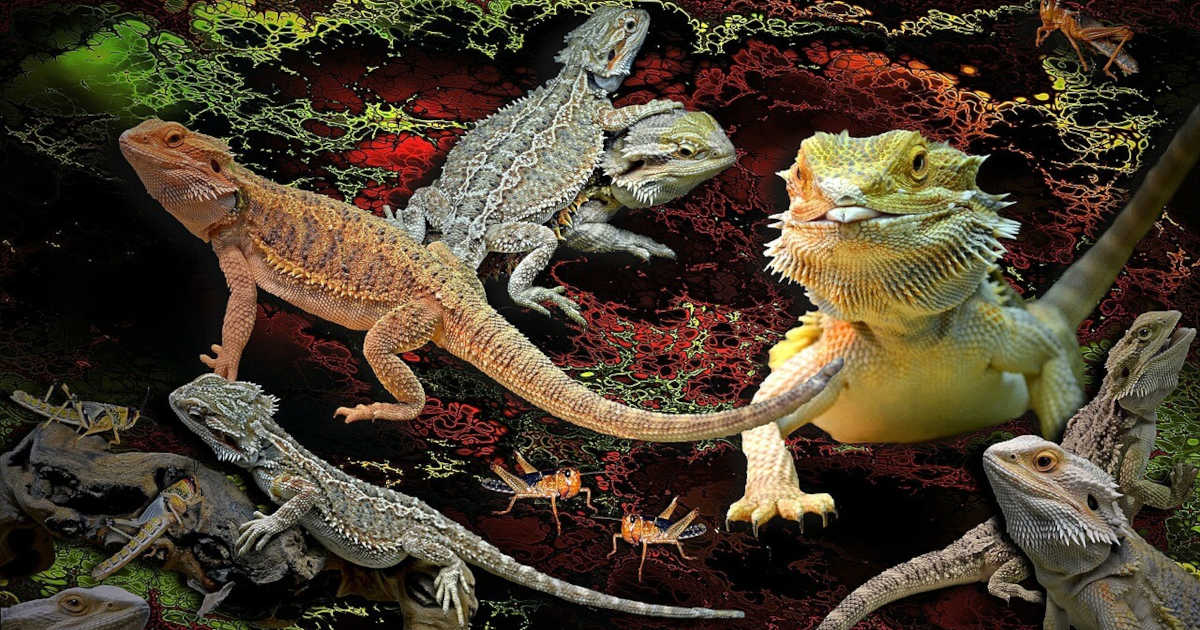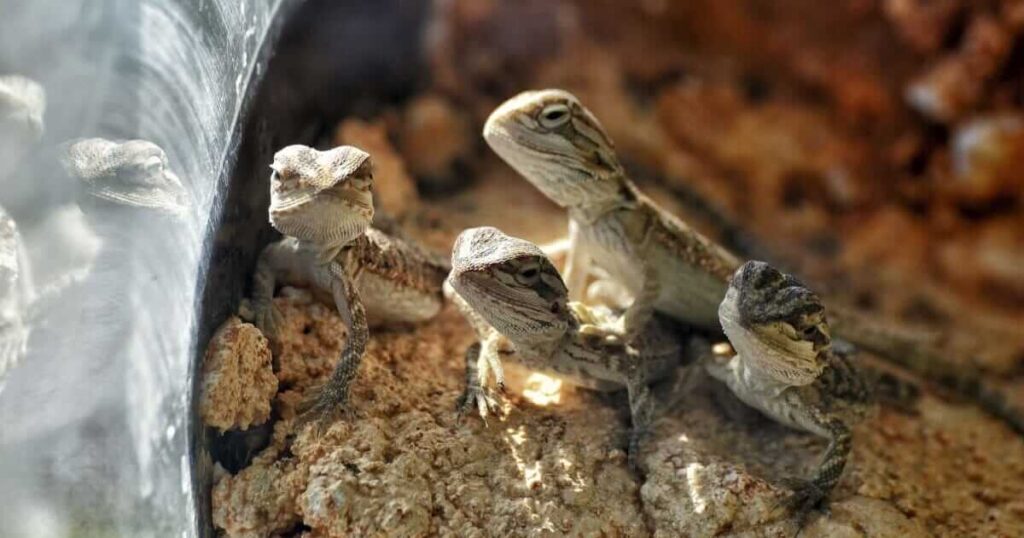Will Bearded Dragons Eat Each Other?
Learn why bearded dragons should not be housed together and find out whether if they are, whether they may go as far as eating each other.

Last Updated: January 4th, 2023
By: Steve
Table of Contents
Without doubt, bearded dragons will eat each other if they decide to. Usually this occurs if an adult bearded dragon is kept in the same tank as a baby. Any bearded dragon that is smaller than the other will be at risk of being eaten.
If bearded dragons of similar sizes are kept together, particularly two male bearded dragons then they may not actually eat each other, but they will attack each other. They will likely eat parts of each other, such as legs or tails.
Bearded dragons do not grow their limbs back, nor their tails if they lose them in a fight.
Are Bearded Dragons Cannibals?
Bearded dragons aren’t specifically cannibals in that they won’t necessarily target each other to eat. But if there’s a lack of food, or one bearded dragon is sufficiently smaller than the other then yes, bearded dragons will cannibalise each other.
Hungry bearded dragons are more at risk of cannibalising each other than ones that are well fed, but do bear in mind there are other reasons why bearded dragons may want to cannibalise each other.
Can Bearded Dragons Kill Each Other?
Yes, bearded dragons are very territorial and will fight over the smallest of things. They will often fight to the death. Bearded dragons will kill each other in order to mate with a female, and if food is scarce, or heat and light is scarce, then they will fight each other to dominate. This fighting can easily lead to one of the bearded dragons being killed – with the other quite possibly seriously injured.
Significant Injury Can Occur Too
Most horror stories we hear and see aren’t actually related to bearded dragons killing each other. But they are vicious fighters and bearded dragons do have sharp teeth which can do some significant damage to each other. If you frequent online platforms such as forums, Facebook or Twitter for example then you’ll probably have seen pictures of bearded dragons with almost no tail, or missing feet or whole legs. This is usually as a result of cohabiting bearded dragons.
So even if they don’t kill each other, they can produce some fairly life changing injuries for each other.
Can You Keep 2 Bearded Dragons Together?
This is not recommended for the reasons listed above. Bearded dragons can easily kill, maim or otherwise injure each other and will do so willingly. They can be very unpredictable with each other and two bearded dragons that have previously lived harmoniously together can suddenly turn on each other for the slightest of reasons.
Bearded dragons are solitary, territorial animals who generally, in the wild, will not interact with each other except to mate. Because of their territorial nature they will usually fight each other (even males fighting females) if they are not wanting to mate.
You’ll Get Very Little Warning Too…
If you ask around on forums online you’ll be told by many people that 2 bearded dragons can be kept together. The people answering will tell you how they do it and they’ve never had a problem. We’ve done it ourselves without too much of an issue. But, this is a crucial question you have to ask yourself first;
“Is it worth the risk?”
We say that because your 2 happy friends living together in the same tank may at some point turn on each other. It might be that the wind changed direction, or 1 doesn’t like the way the other looked at the pea-shoots this morning. You’ll get almost no warning and then they’ll be at it. It might not happen, but it does happen fairly regularly so do be aware. Make sure you have somewhere to separate them to if you are going to put them together, as you may need it suddenly.
Can Two Female Bearded Dragons Live Together?
This is generally considered the safer option for any 2 bearded dragons being housed together but it is still not recommended. Although female bearded dragons are more tolerant with each other and may not specifically pick fights with each other, they almost certainly will compete for food, heat and light. One of the females will likely out-dominate the other for the best parts of the tank and the most food.
This means that the less dominant of the two is likely to thrive less well and may end up with metabolic bone disease or other illnesses over the course of time. It’s recommended to keep bearded dragons separately for this reason.
Having said that, we successfully housed 2 female bearded dragons together that we ‘rescued’ from a pet shop. They had allegedly always lived together and they did well together. During our time with them (one has now passed away from egg dystocia) they never fought although Ruby was very much the dominant one. She was quite passive aggressive about it all though and Billy just kept her distance for the most part. It’s fair to say though, that even these two had issues when Ruby became ill. Billy felt that was her chance to take over the pecking order and we did have to keep an eye on them and seperate them while we nursed Ruby.
Will Bearded Dragons Fight Each Other?
Bearded dragons will almost always fight each other if they come into contact. There are rare occasions where two bearded dragons can live together or see each other but in most cases this is just asking for an injured bearded dragon.
As we’ve seen above, bearded dragons of different sizes will eat each other without question. If they are of similar size they will compete for resources such as food, light and heat. And since they’re solitary and territorial they will fight each other if either one of them decides the other is in its space.
Can I Put A Baby Bearded Dragon With An Older One?
Absolutely not. Never ever put a baby bearded dragon in the same tank as an older dragon. Your baby bearded dragon will get injured or killed and eaten.
You may have heard people online say that they have successfully kept a baby bearded dragon with an older one with ‘no harm done’. These are rare instances and the owners who have done this have simply been extremely lucky. And even then, there is harm done that the owner has not realised, perhaps due to inexperience.
There is no good reason to keep a baby bearded dragon with an adult dragon in the same tank.
Can You Put 2 Baby Bearded Dragons Together?

This can work temporarily until the bearded dragons get bigger and become more territorial. Pet stores often house baby bearded dragons together and when they do there are often 5 or 10 in one area. This is definitely not recommended. 2 can work. But remember, bearded dragons are territorial and even babies carry the risk of attacking and killing each other if they get the urge.
So whilst baby bearded dragons can be housed together in the same tank, it’s still not recommended – especially if the tank is small. If you must house two baby bearded dragons together, give them some room to escape each other and stay out of each other’s way if they decide. And ensure this only a very temporary measure.
Other Risks of Housing Baby Bearded Dragons Together
One aspect of housing baby bearded dragons (or indeed any bearded dragons) together is that of infectious disease. This catches pet stores out quite often since they regularly house babies together and don’t clean their tanks properly when the last one is sold either. Diseases such as yellow fungus are highly contagious and can be deadly. Keeping baby bearded dragons separately helps reduce the risk of this disease spreading and is another very good reason to not house baby bearded dragons together.
Do Bearded Dragons Get Lonely?
Bearded dragons are, by their very nature, solitary animals. They show no evidence in captivity of being lonely when they’re kept on their own. They display considerable evidence of not wanting other bearded dragons (or any lizard) in their space however. They do this by attacking other bearded dragons, or other lizards in their enclosures.
Bearded dragons do require stimulation though in order to thrive and enjoy life. A sterile looking enclosure with limited climbing places or hiding places will potentially be less exciting for a bearded dragon than one with plenty of places to climb up high and survey their kingdom. Each bearded dragon is different though.
For some ideas for how you can keep your bearded dragon active and not bored, click here.
Will a Bearded Dragon Eat Another Lizard?
The short answer to this question is yes, if they get the opportunity. The slightly longer answer is that it rather does depend on the size of the other lizard. For example, an adult Green Iguana can grow up to 1.5 meters in length which is significantly bigger than a bearded dragon. It’s unlikely that a bearded dragon will try to eat one of those. But something smaller like, a leopard gecko for example would easily become a snack for a bearded dragon.
By far the safest approach though is to keep bearded dragons away from any other lizards, no matter the size. There’s always a strong possibility – even with the herbivorous Green Iguana – that they’ll fight each other for the space and that will likely to lead to injury even if they don’t intend on actually eating each other.
Summary
Bearded dragons kept in the same enclosure have significant risk of injuring or killing each other. If there is a size and/or age difference between the two this risk is increased significantly as the larger one may well see the smaller one simply as a snack.
Two females together carries the least risk as the females are often less aggressive than males. Two males should absolutely never be housed together and should not be allowed to spend time with each other as they will, at some point, fight. They will turn on each other unpredictably and quickly and may take you by surprise. Keep them separate and avoid the trauma and heartache of an injured bearded dragon.
Even two females together carry a significant injury or failure to thrive risk. As do babies.
By far the safest approach is to keep bearded dragons separately from each other and do not let them interact with each other. They do not get lonely and they do not need play dates.
If you’ve found this post useful please feel free to share it using the buttons below. If you would like to give us any feedback or comment on your experiences please leave us a comment using the form below.
